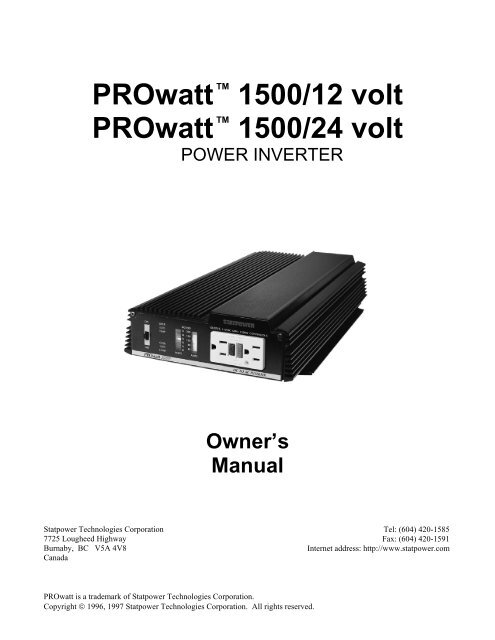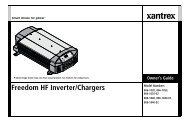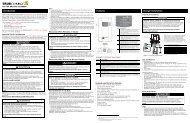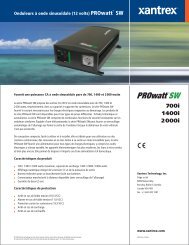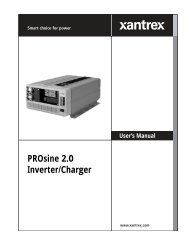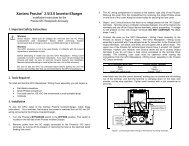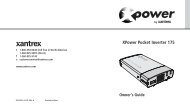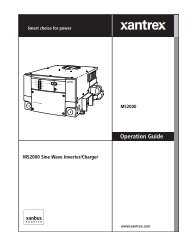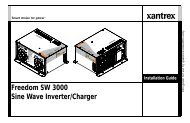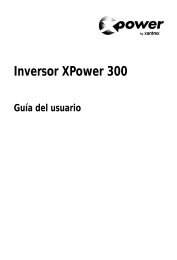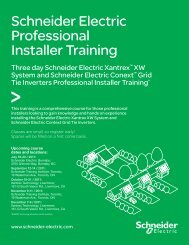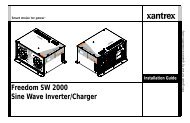You also want an ePaper? Increase the reach of your titles
YUMPU automatically turns print PDFs into web optimized ePapers that Google loves.
<strong>PROwatt</strong><br />
TM<br />
<strong>1500</strong>/<strong>12</strong> <strong>volt</strong><br />
<strong>PROwatt</strong><br />
TM<br />
<strong>1500</strong>/24 <strong>volt</strong><br />
POWER INVERTER<br />
Owner’s<br />
Manual<br />
Statpower Technologies Corporation Tel: (604) 420-1585<br />
7725 Lougheed Highway<br />
Fax: (604) 420-1591<br />
Burnaby, BC V5A 4V8<br />
Internet address: http://www.statpower.com<br />
Canada<br />
<strong>PROwatt</strong> is a trademark of Statpower Technologies Corporation.<br />
Copyright © 1996, 1997 Statpower Technologies Corporation. All rights reserved.
Table of Contents<br />
1 Introduction ...........................................................................................................................................................1<br />
2 How Your <strong>PROwatt</strong> <strong>1500</strong> Works.........................................................................................................................1<br />
2.1 Principle of Operation .............................................................................................................................1<br />
2.2 <strong>PROwatt</strong> <strong>1500</strong> Output Waveform ...........................................................................................................3<br />
3 Quick Checkout ....................................................................................................................................................4<br />
3.1 Power Source...........................................................................................................................................4<br />
3.2 Cables ......................................................................................................................................................4<br />
3.3 Test Loads ...............................................................................................................................................5<br />
3.4 Connections.............................................................................................................................................5<br />
4 Installation ............................................................................................................................................................6<br />
4.1 Where to Install .......................................................................................................................................6<br />
4.2 Battery .....................................................................................................................................................6<br />
Battery Type.....................................................................................................................................7<br />
Battery Sizing...................................................................................................................................8<br />
Using Multiple Batteries ..................................................................................................................9<br />
Battery Tips ....................................................................................................................................10<br />
Alternators and Charging Systems .................................................................................................11<br />
4.3 Cables ....................................................................................................................................................<strong>12</strong><br />
4.4 Connections...........................................................................................................................................<strong>12</strong><br />
AC Wiring ......................................................................................................................................<strong>12</strong><br />
Ground Wiring ..............................................................................................................................15<br />
DC Wiring ......................................................................................................................................16<br />
4.5 Remote Panel.........................................................................................................................................17<br />
Installation Instructions ..................................................................................................................17<br />
Operating Instructions ....................................................................................................................17<br />
5 Operation ............................................................................................................................................................18<br />
5.1 Outlets, Controls and Indicators............................................................................................................18<br />
5.2 Operating Limits...................................................................................................................................19<br />
6 Troubleshooting..................................................................................................................................................20<br />
6.1 Common Problems ................................................................................................................................20<br />
6.2 Troubleshooting Guide..........................................................................................................................21<br />
7 Maintenance........................................................................................................................................................22<br />
8 Warranty.............................................................................................................................................................22<br />
8.1 Warranty Terms.....................................................................................................................................22<br />
8.2 To Obtain Warranty Service.................................................................................................................22<br />
9 Specifications ......................................................................................................................................................24<br />
9.1 Electrical Performance ..........................................................................................................................24<br />
9.2 Dimensions............................................................................................................................................24<br />
<strong>PROwatt</strong> is a trademark of Statpower Technologies Corporation.<br />
Copyright © 1996, 1997 Statpower Technologies Corporation. All rights reserved.
1 Introduction<br />
Your new <strong>PROwatt</strong> <strong>1500</strong> inverter is a member of the most advanced line of dc to ac inverters available today. It<br />
will give you years of dependable service in your boat, RV, service vehicle or remote home.<br />
To get the most out of your <strong>PROwatt</strong> <strong>1500</strong>, it must be installed and used properly. Please read the installation and<br />
operating instructions in this manual carefully before installing and using your <strong>PROwatt</strong> <strong>1500</strong>. Pay special attention<br />
to the CAUTION and WARNING statements in this manual and on the <strong>PROwatt</strong> <strong>1500</strong>. CAUTION statements<br />
identify conditions or practices which could result in damage to your <strong>PROwatt</strong> <strong>1500</strong> or to other equipment.<br />
WARNING statements identify conditions or practices that could result in personal injury or loss of life.<br />
2 How Your <strong>PROwatt</strong> <strong>1500</strong> Works<br />
An inverter is an electronic device that converts low <strong>volt</strong>age DC (direct current) electricity from a battery or other<br />
power source to standard 115 <strong>volt</strong> AC (alternating current) household power. In designing the <strong>PROwatt</strong> <strong>1500</strong>,<br />
Statpower has used power conversion technology previously employed in computer power supplies to give you<br />
an inverter that is smaller, lighter, and easier to use than inverters based on older technology.<br />
2.1 Principle of Operation<br />
The <strong>PROwatt</strong> <strong>1500</strong> converts power in two stages. The first stage is a DC-to-DC converter which raises the low<br />
<strong>volt</strong>age DC at the inverter input to 145 <strong>volt</strong>s DC. The second stage is the actual inverter stage. It converts the<br />
high <strong>volt</strong>age DC into 115 <strong>volt</strong>s, 60 Hz AC.<br />
The DC-to-DC converter stage uses modern high frequency power conversion techniques that eliminate the bulky<br />
transformers found in inverters based on older technology. The inverter stage uses advanced power MOSFET<br />
transistors in a full bridge configuration. This gives you excellent overload capability and the ability to operate<br />
tough reactive loads like lamp ballasts and induction motors.<br />
Figure 1. <strong>PROwatt</strong> <strong>1500</strong> - Principle of Operation<br />
1
2.2 <strong>PROwatt</strong> <strong>1500</strong> Output Waveform<br />
The AC output waveform of the <strong>PROwatt</strong> <strong>1500</strong> is called a "quasi-sine wave" or a "modified sine wave". It is a<br />
stepped waveform that is designed to have characteristics similar to the sine wave shape of utility power. A<br />
waveform of this type is suitable for most AC loads, including linear and switching power supplies used in electronic<br />
equipment, transformers, and motors. This waveform is much superior to the square wave produced by<br />
many other dc to ac inverters.<br />
CAUTION! RECHARGEABLE APPLIANCES<br />
Certain rechargers for small nickel cadmium batteries can be damaged if connected to the <strong>PROwatt</strong>. Two<br />
particular types of equipment are prone to this problem:<br />
1) small battery operated appliances such as flashlights, razors, and night lights that can be plugged directly<br />
into an ac receptacle to recharge.<br />
2) certain battery chargers for battery packs used in hand power tools. These chargers have a<br />
WARNING label stating that dangerous <strong>volt</strong>ages are present at the battery terminals.<br />
Do NOT use the <strong>PROwatt</strong> with the above equipment.<br />
This problem does not occur with the vast majority<br />
of battery operated equipment. Most of<br />
this equipment uses a separate charger or transformer<br />
that is plugged into the ac receptacle<br />
and produces a low <strong>volt</strong>age output. If the label<br />
on the ac adapter or charger states that the<br />
adapter or charger produces a low <strong>volt</strong>age ac or<br />
dc output (less than 30 <strong>volt</strong>s), the <strong>PROwatt</strong> will<br />
have no trouble powering this charger or<br />
adapter safely.<br />
The modified sine wave produced by the<br />
Figure 2. Modified Sine Wave<br />
<strong>PROwatt</strong> <strong>1500</strong> is designed to have an RMS<br />
(root mean square) <strong>volt</strong>age of 115 <strong>volt</strong>s, the same as standard household power. Most AC <strong>volt</strong>meters (both digital<br />
and analog) are sensitive to the average value of the waveform rather than the RMS value. They are calibrated for<br />
RMS <strong>volt</strong>age under the assumption that the waveform measured will be a pure sine wave. These meters will not<br />
read the RMS <strong>volt</strong>age of a modified sine wave correctly. They will read about 2 to 20 <strong>volt</strong>s low when measuring<br />
the output of the <strong>PROwatt</strong> <strong>1500</strong>. For accurate measurement of the output <strong>volt</strong>age of the <strong>PROwatt</strong> <strong>1500</strong>, a true<br />
RMS reading <strong>volt</strong>meter, such as a Fluke 87, Fluke 8060A, Beckman 4410, or Triplett 4200, must be used.<br />
3
3 Quick Checkout<br />
This section will give you the information you need to quickly hook-up your <strong>PROwatt</strong> <strong>1500</strong> and check its performance<br />
before going ahead with permanent installation. You will need the following:<br />
a) a <strong>12</strong> <strong>volt</strong> DC power source (24 <strong>volt</strong> for PW<strong>1500</strong>/24)<br />
b) two cables to connect the power source to the <strong>PROwatt</strong> <strong>1500</strong><br />
c) a test load that can be plugged into the AC receptacle on the <strong>PROwatt</strong> <strong>1500</strong>.<br />
3.1 Power Source<br />
The power source must provide between 11 and 15 <strong>volt</strong>s (22 and 30 <strong>volt</strong>s for PW<strong>1500</strong>/24) DC and must be able<br />
to supply sufficient current to operate the test load. As a rough guideline, divide the wattage of the test load by 10<br />
(by 20 for PW<strong>1500</strong>/24) to obtain the current (in amperes) the power source must deliver.<br />
Example: Test load is rated at 250 watts. Power source must be able<br />
to deliver 250 ÷ 10 = 25 amperes (or <strong>12</strong>.5Amps for 24 <strong>volt</strong> model).<br />
Battery<br />
Use a fully-charged <strong>12</strong> <strong>volt</strong> (nominal) battery that can deliver the required current while maintaining its <strong>volt</strong>age<br />
above 11 <strong>volt</strong>s (22 <strong>volt</strong>s for 24 <strong>volt</strong> battery system). A fully-charged (<strong>12</strong> <strong>volt</strong>) automobile battery is capable of<br />
delivering up to 50 amperes without an excessive <strong>volt</strong>age drop.<br />
DC Power Supply<br />
Use a well regulated DC power supply that has an output <strong>volt</strong>age between 11 <strong>volt</strong>s and 15 <strong>volt</strong>s (22-30 <strong>volt</strong>s for<br />
PW<strong>1500</strong>/24) and can deliver the required current. If the supply is adjustable, make sure that the output <strong>volt</strong>age is<br />
adjusted to be between 11 <strong>volt</strong>s and 15 <strong>volt</strong>s (22-30 <strong>volt</strong>s for PW<strong>1500</strong>/24) the inverter may shut down if the <strong>volt</strong>age<br />
is outside these limits and may be damaged if the <strong>volt</strong>age is above 16 <strong>volt</strong>s (32 <strong>volt</strong>s for PW<strong>1500</strong>/24). Also<br />
ensure that any current limit control is set so that the power supply can deliver the required current.<br />
3.2 Cables<br />
Your cables must be as short as possible and large enough to handle the required current. This is to minimize the<br />
<strong>volt</strong>age drop between the power source and the inverter when the inverter is drawing current from the power<br />
source. If the cables introduce an excessive <strong>volt</strong>age drop, the inverter may shut down when drawing higher currents<br />
because the <strong>volt</strong>age at the inverter drops below 10 <strong>volt</strong>s (20 <strong>volt</strong>s on PW<strong>1500</strong>/24).<br />
We recommend #2 AWG (#4 AWG on PW<strong>1500</strong>/24) stranded copper cable that is no longer than 4 ft (1.2 metres)<br />
if you want to test the <strong>PROwatt</strong> <strong>1500</strong> to its maximum ratings. For short term testing at reduced power levels, the<br />
guidelines below should be followed:<br />
Test Load Power Minimum Cable Size Minimum Cable Size<br />
Consumption For PW<strong>1500</strong>/<strong>12</strong> <strong>volt</strong> PW<strong>1500</strong>/24 <strong>volt</strong><br />
Short Term Test<br />
100 watts #16 AWG copper #18 AWG copper<br />
250 watts #<strong>12</strong> AWG copper #16 AWG copper<br />
500 watts #8 AWG copper #<strong>12</strong> AWG copper<br />
Ideally, the cable should be no more than 4 ft (1.2 meters) long.<br />
The end of the cable to be connected to the inverter must have its insulation stripped for about 1/2 inch (1.25 cm)<br />
back from the end, exposing the bare copper conductor. The other end of the cable, which is connected to the<br />
4
power source, must be terminated with a lug or other connector that allows a secure, low resistance connection to<br />
be made to the power source. For instance, if the power source is a battery, the cable must be terminated with a<br />
battery terminal that clamps to the post on the battery.<br />
A solid, low resistance connection to the power source is essential for proper operation of the <strong>PROwatt</strong><br />
<strong>1500</strong>.<br />
3.3 Test Loads<br />
Use only equipment rated for 110-<strong>12</strong>0 <strong>volt</strong>, 60 Hz AC operation that has a power consumption of <strong>1500</strong> watts or<br />
less. We recommend that you start with a relatively low power load, such as 100 watt lamp, to verify your test<br />
set-up before trying high power loads.<br />
3.4 Connections<br />
Figure 3. Connections to the <strong>PROwatt</strong> <strong>1500</strong><br />
Follow the connection sequence described below.<br />
STEP 1 Ensure that the ON/OFF switch on the <strong>PROwatt</strong> <strong>1500</strong> is in the OFF position. If the power source is a DC<br />
power supply, switch it off as well.<br />
STEP 2 Connect the cables to the power input terminals on the rear panel of the <strong>PROwatt</strong> <strong>1500</strong>. The red terminal<br />
is positive (+) and the white terminal is negative (-). Insert the bare ends of the cables into the terminals<br />
and tighten the screws to clamp the wires securely.<br />
STEP 3 Connect the cable from the negative (white) terminal of the <strong>PROwatt</strong> <strong>1500</strong> to the negative terminal of the<br />
power source. Make a secure connection.<br />
CAUTION! Loosely tightened connectors result in excessive <strong>volt</strong>age drop and may cause overheated wires<br />
and melted insulation.<br />
STEP 4 Before proceeding further, carefully check that the cable you have just connected connects the negative<br />
terminal of the <strong>PROwatt</strong> <strong>1500</strong> to the negative output terminal of the power source. Power connections<br />
to the <strong>PROwatt</strong> <strong>1500</strong> must be positive to positive and negative to negative.<br />
CAUTION! Reverse polarity connection (positive to negative) will blow the fuses in the <strong>PROwatt</strong> <strong>1500</strong> and<br />
may permanently damage the <strong>PROwatt</strong> <strong>1500</strong>. Damage caused by reverse polarity connection is not covered<br />
by your warranty.<br />
STEP 5 Connect the cable from the positive (red) terminal of the <strong>PROwatt</strong> <strong>1500</strong> to the positive terminal of the<br />
power source. Make a secure connection.<br />
5
WARNING! You may observe a spark when you make this connection since current may flow to charge capacitors<br />
in the <strong>PROwatt</strong> <strong>1500</strong>. Do not make this connection in the presence of flammable fumes. Explosion or<br />
fire may result.<br />
STEP 6 If you are using a DC power supply as the power source, switch it on. Set the ON/OFF switch on the<br />
<strong>PROwatt</strong> <strong>1500</strong> to the ON position. Check the meters and indicators on the front panel of the <strong>PROwatt</strong><br />
<strong>1500</strong>. The <strong>volt</strong>age bar graph should indicate 11 to 14 <strong>volt</strong>s (22-28 <strong>volt</strong>s for PW<strong>1500</strong>/24), depending on<br />
the <strong>volt</strong>age of the power source. If it does not, check your power source and the connections to the<br />
<strong>PROwatt</strong> <strong>1500</strong>. The other indicators should be off.<br />
STEP 7 Set the <strong>PROwatt</strong> <strong>1500</strong> ON/OFF switch to the OFF position. The indicator lights may blink and the internal<br />
alarm may sound momentarily. This is normal. Plug the test load into the AC receptacle on the<br />
front panel of the <strong>PROwatt</strong> <strong>1500</strong>. Leave the test load switched off.<br />
STEP 8 Set the <strong>PROwatt</strong> <strong>1500</strong> ON/OFF switch to the ON position and turn the test load on. The <strong>PROwatt</strong> <strong>1500</strong><br />
should supply power to the load. If it does not, refer to the troubleshooting section of this manual. If<br />
you plan to measure the output <strong>volt</strong>age of the <strong>PROwatt</strong> <strong>1500</strong>, refer to Section 2.2 of this manual.<br />
4 Installation<br />
4.1 Where to Install The <strong>PROwatt</strong> <strong>1500</strong> should be installed in a location that meets the following requirements:<br />
a) Dry - do not allow water to drip or splash on the <strong>PROwatt</strong> <strong>1500</strong>.<br />
b) Cool - ambient air temperature should be between 0 o C and 40 o C (30 o F and 105 o F) the cooler the better.<br />
c) Ventilated - allow at least 1 inch (2.5cm) of clearance around the <strong>PROwatt</strong> <strong>1500</strong> for air flow. Ensure<br />
that ventilation openings on the rear and bottom of the unit are not obstructed.<br />
d) Safe - do not install the <strong>PROwatt</strong> in the same compartment as batteries or in any compartment capable<br />
of storing flammable liquids such as gasoline.<br />
e) Close to Battery - install as close to the battery as possible in order to minimize the length of cable required<br />
to connect the inverter to the battery. It is better and cheaper to run longer AC wires than<br />
longer DC cables.<br />
CAUTION! To prevent fire, do not cover or obstruct ventilation openings. Do not install the <strong>PROwatt</strong><br />
<strong>1500</strong> in a zero-clearance compartment. Overheating may result.<br />
WARNING! This equipment contains components which tend to produce arcs or sparks. To prevent fire<br />
or explosion do not install in compartments containing batteries or flammable materials or in locations<br />
which require ignition protected equipment.<br />
Mount the <strong>PROwatt</strong> on a flat surface using the mounting bracket on the bottom. Mounting hardware should be<br />
corrosion resistant and #10 or larger. The <strong>PROwatt</strong> may be mounted horizontally or vertically.<br />
4.2 Battery<br />
6
The battery you use strongly affects the performance you can expect from your <strong>PROwatt</strong> <strong>1500</strong>. It is important to<br />
connect the <strong>PROwatt</strong> <strong>1500</strong> to the correct size and type of battery. The following information will help you select<br />
the appropriate batteries for your application.<br />
Battery Type<br />
The lead-acid battery which is probably most familiar<br />
is the starting battery in your automobile. An<br />
automotive starting battery is designed to deliver a<br />
large amount of current for a short period of time<br />
(so it can start your engine). Only a small portion<br />
of the battery's capacity is used when starting the<br />
engine and it is quickly recharged by the running<br />
engine. It is not designed for repeated chargedischarge<br />
cycles where the battery is almost completely<br />
discharged and then recharged. If it is used<br />
in this kind of deep discharge service, it will wear<br />
out very rapidly.<br />
Figure 4. <strong>PROwatt</strong> <strong>1500</strong> Connected Directly to Engine Battery<br />
for Light-Duty Applications<br />
Deep-cycle lead-acid batteries are designed for<br />
deep discharge service where they will be repeatedly<br />
discharged and recharged. They are marketed for use in recreational vehicles, boats, and electric golf carts<br />
so you may see them referred to as RV batteries, marine batteries, or golf cart batteries.<br />
For most applications of the <strong>PROwatt</strong> <strong>1500</strong>, Statpower recommends that you use one or more deep-cycle batteries<br />
that are separated from the starting battery in your vehicle by a battery isolator. A battery isolator is a solid-state<br />
electronic circuit which allows equipment to be operated from an auxiliary battery without danger of discharging<br />
the vehicle's starting battery. During vehicle operation, the battery isolator automatically directs the charge from<br />
the alternator to the battery requiring the charge. Battery isolators can be obtained at marine and RV dealers and<br />
most auto parts stores.<br />
If your application involves relatively low power loads (i.e. power consumption of 300 watts or less) and relatively<br />
short operating times before recharging (one hour or less), you may connect the <strong>PROwatt</strong> <strong>1500</strong> directly to<br />
the vehicle starting battery.<br />
CAUTION! The <strong>PROwatt</strong> <strong>1500</strong>/<strong>12</strong><br />
must be connected only to batteries<br />
with a nominal output <strong>volt</strong>age of <strong>12</strong><br />
<strong>volt</strong>s . The <strong>PROwatt</strong> <strong>1500</strong>/<strong>12</strong> will not<br />
operate from a 6 <strong>volt</strong> battery, and will<br />
be damaged if it is connected to a 24<br />
<strong>volt</strong> battery. The PW<strong>1500</strong>/24 must be<br />
connected only to a 24 <strong>volt</strong> battery<br />
system. The PW<strong>1500</strong>/24 will not operate<br />
from a 6 or <strong>12</strong> <strong>volt</strong> battery.<br />
Figure 5. Recommended Battery Configuration for Medium-Duty<br />
Applications<br />
7
Battery Sizing<br />
Unfortunately, there are a number of different standards for rating battery energy storage capacity. <strong>12</strong> <strong>volt</strong> Automotive<br />
starting batteries are normally rated by cranking amps. This is not a relevant rating for continuous use.<br />
Deep-cycle batteries are rated either by reserve capacity in minutes or by ampere-hour capacity.<br />
Battery reserve capacity is a measure of how long a battery can deliver a certain amount of current - usually 25<br />
amperes. For instance, a battery with a reserve capacity of 180 minutes can deliver 25 amperes for 180 minutes<br />
before it is completely discharged.<br />
Ampere-hour capacity is a measure of how many amperes a battery can deliver for a specified length of time -<br />
usually 20 hours. For example, a typical marine or RV battery rated for 100 ampere-hours can deliver 5 amperes<br />
for 20 hours (5 amperes x 20 hours = 100 amp-hrs).<br />
Actual battery capacity decreases as discharge current increases. A battery rated at 100 ampere-hours which can<br />
deliver 5 amperes for 20 hours, may deliver 20 amperes for only 4 hours, resulting in an actual capacity of 80 ampere-hours.<br />
For this reason, it is difficult to compare rated ampere-hour capacity with battery reserve capacity.<br />
For example a battery with a reserve capacity of 180 minutes has the following calculated ampere-hour capacity:<br />
180 min.÷ 60 = 3 hr., 3 hr. x 25 amps = 75 amp-hrs<br />
However its actual ampere-hour rating will be closer to 100 ampere-hours because it is rated at the discharge current<br />
required to get 20 hours of operation (about 5 amperes).<br />
To determine the battery capacity you require, follow these steps:<br />
STEP 1 For each piece of equipment you will be operating from the <strong>PROwatt</strong> <strong>1500</strong>, determine how many watts it<br />
consumes. This can normally be found on a label on the product. If only the current draw is given, multiply<br />
the current draw by 115 to get the power consumption in watts.<br />
STEP 2 For each piece of equipment you will be operating from the <strong>PROwatt</strong> <strong>1500</strong>, estimate how many hours it<br />
will operate between battery charging cycles.<br />
STEP 3 Calculate total watt-hours of energy consumption, total hours running time, and average power consumption<br />
as in the following example:<br />
Equipment Power Consumption Operating Time Watt - Hours (Power x Operating Time)<br />
TV & VCR 115 watts 3 hours 345<br />
Sewing Machine 150 watts 1 hour 150<br />
Waterpik 90 watts 0.25 hour 22.5<br />
Blender 300 watts 0.25 hour 75<br />
Coffee Maker 750 watts 0.3 hour 225<br />
Coffee Grinder 100 watts 0.l hour 10<br />
Microwave Oven <strong>1500</strong> watts 0.5 hour 750<br />
Totals 5.4 hours 1577.5 watt-hours<br />
8
INVERTER<br />
BATTERY SIZE<br />
OUTPUT BCI GROUP SIZE: 20NF 24 27 8D DUAL 8D's<br />
POWER TYPICAL LOAD RESERVE CAPACITY 90 MINUTES 140 MINUTES 180 MINUTES 400 MINUTES 900 MINUTES<br />
(WATTS) AMP-HRS: 50 75 100 200 400<br />
50 STEREO SYSTEM OPERATING TIME: 9 HOURS 14 HOURS 20 HOURS 40 HOURS 80 HOURS<br />
100 19" COLOR TV OPERATING TIME: 4 HOURS 6 HOURS 10 HOURS 20 HOURS 40 HOURS<br />
200 COMPUTER SYSTEM OPERATING TIME: 2 HOURS 3 HOURS 4.5 HOURS 10 HOURS 20 HOURS<br />
300 BLENDER OPERATING TIME: 1.3 HOURS 2.2 HOURS 3 HOURS 6 HOURS <strong>12</strong> HOURS<br />
400 POWER DRILL OPERATING TIME: 1 HOUR 1.5 HOURS 2 HOURS 4.5 HOURS 10 HOURS<br />
600 SMALL COFFEE MAKER OPERATING TIME: N.R. N.R. 1 HOUR 2.5 HOURS 6 HOURS<br />
800 SMALL MICROWAVE OVEN OPERATING TIME: N.R. N.R. N.R. 1.5 HOURS 4 HOURS<br />
1000 TOASTER OPERATING TIME: N.R. N.R. N.R. 1 HOUR 3 HOURS<br />
<strong>1500</strong> FULL SIZE MICROWAVE OPERATING TIME: N.R. N.R. N.R. 0.5 HOURS 2 HOURS<br />
N.R. - NOT RECOMMENDED<br />
Figure 6. <strong>12</strong> Volt Battery Sizing Chart<br />
Average Power Consumption = 1577.5 watt-hrs ÷ 5.4 hours = 292 watts<br />
<strong>12</strong> <strong>volt</strong> Ampere-Hours Consumed = Watt-hours ÷ 10 = 1577.5 ÷ 10 = 157.8 ampere-hours<br />
or, for PW<strong>1500</strong>/24 <strong>volt</strong> system, Consumption = 1577.5 watt-hours = 292 watts<br />
24 <strong>volt</strong> Ampere-Hours Consumed = Watt-hours ÷ 20 = 1577.5 ÷ 20 = 79 ampere-hours<br />
Step 4<br />
Using the chart above (figure 6), find the battery size that will give you the required operating time at the<br />
calculated average power consumption. For instance, from the example above, the required operating<br />
time is 5.4 hours and the average power consumption is 292 watts. From the chart, the smallest battery<br />
size which will give more than 5 hours of operation at a power level between 200 and 300 watts is the<br />
200 amp-hr. battery, which offers between 6 and 10 hours of operating time.<br />
When sizing your battery, be generous. More capacity is better since you will have more reserve capacity, and<br />
your battery won't be discharged as deeply. Battery life is directly dependent on how deeply the battery is discharged.<br />
The deeper the discharge, the shorter the battery life. Ideally, the number of ampere-hours consumed by<br />
your loads before recharging the battery should be no more than 50% of the battery's rated capacity.<br />
Using Multiple Batteries<br />
To obtain sufficient battery capacity you may need to use more than<br />
one battery. Two identical batteries can be connected + to + and -<br />
to - in a parallel system that doubles capacity and maintains the<br />
<strong>volt</strong>age of a single battery. Do not connect batteries from different<br />
manufacturers, or with different amp-hr ratings, in parallel . Decreased<br />
battery life may result.<br />
If you are using different batteries, or need to use more than two<br />
batteries, we recommend that you set up two separate battery banks<br />
and use them alternately. Battery selector switches are available<br />
from marine and RV dealers which allow you to select between two<br />
banks of batteries, or use both in parallel, or disconnect both from<br />
the load.<br />
Figure 7. Parallel Connection of Two Batteries<br />
9
Figure 8. Recommended Battery Configuration for Heavy-Duty Applications<br />
Note: PW<strong>1500</strong>/24 model inverter only: 24 Volt systems typically have 2 x <strong>12</strong> Volt batteries connected in series.<br />
Battery Tips<br />
1. With the exception of sealed, gel cell batteries, lead-acid batteries emit hydrogen and oxygen gases, and sulfuric<br />
acid fumes when recharging. Vent the battery compartment to prevent accumulation of these gases, and do<br />
not install electronic or electrical equipment in the battery compartment. Do not smoke or carry an open flame<br />
when working around batteries.<br />
2. The capacity of lead-acid batteries is temperature sensitive. Battery capacity is rated at 25 o C (77 o F). At<br />
20 o C (0 o F) the ampere-hour capacity will be about half the rated capacity.<br />
3. Do not leave batteries in a discharged state for more than a day or two. They will undergo a chemical process<br />
called sulfation which can permanently damage the battery. Also, batteries will self-discharge over a period of<br />
3 to 6 months, so they should be periodically recharged even if they are not being used.<br />
10
4. If your batteries are not the "maintenance-free" type, check the electrolyte fluid level at least once a month.<br />
Use only distilled water to replenish the electrolyte fluid. Excessive fluid loss is a sign of overcharging.<br />
5. Connections to battery posts must be made with permanent connectors that provide a reliable, low-resistance<br />
connection. Do not use "alligator" clips. Clean the connections regularly and prevent corrosion by using a<br />
protective spray coating or vaseline.<br />
6. Battery state of charge can be measured with a hydrometer or, more easily, with a <strong>volt</strong>meter. Use a digital<br />
<strong>volt</strong>meter that can display tenths or hundredths of a <strong>volt</strong> when measuring 10 to 30 <strong>volt</strong>s. Make your measurements<br />
after the (<strong>12</strong> <strong>volt</strong>) battery has not been charged or discharged for several hours. For a deep-cycle battery<br />
at 25 o C (77 o F), the following table may be used:<br />
Battery Voltage<br />
State-of-Charge<br />
Alternators and Charging Systems<br />
<strong>12</strong>.7 - <strong>12</strong>.9 100%<br />
<strong>12</strong>.5 - <strong>12</strong>.6 80%<br />
<strong>12</strong>.3 - <strong>12</strong>.4 60%<br />
<strong>12</strong>.1 - <strong>12</strong>.2 40 %<br />
11.9 - <strong>12</strong>.0 20%<br />
A good charging system is important for the health of your batteries. Poor recharging methods can quickly damage<br />
your batteries. When possible, recharge your batteries when they are about 50% discharged. This will give<br />
you much longer battery cycle life than recharging when the batteries are almost completely discharged. The Statpower<br />
TRUEcharge family of battery chargers are designed to maximize your batteries performance and useful<br />
life (see your Statpower dealer for more details).<br />
The charging system should be capable of delivering a charging current equal to 25% of the ampere-hour capacity<br />
of your battery. For instance, if you have a 200 ampere-hour battery, the charging system should be able to deliver<br />
50 amperes. The charging system must also be able to charge each <strong>12</strong> <strong>volt</strong> battery up to approximately 14.4<br />
<strong>volt</strong>s and then drop back to a "float" <strong>volt</strong>age of 13.5 to 14 <strong>volt</strong>s (or shut off).<br />
A typical engine alternator (<strong>12</strong> Volt) may not be able to meet these requirements if large capacity batteries are<br />
used. Alternators are typically rated for the current they can deliver when they are cold. In actual use, alternators<br />
heat up and their output current capability drops by as much as 25%. Thus standard alternators with ratings of 40<br />
amperes to 105 amperes will only deliver a maximum of 30 to 80 amperes in actual use and will deliver even less<br />
as battery <strong>volt</strong>age rises. Many alternators cannot produce more than 13.6 <strong>volt</strong>s when they are hot. As a result, a<br />
standard alternator may not be able to charge a large battery quickly and completely.<br />
One solution is to install an alternator controller that will bypass the <strong>volt</strong>age regulator and boost the alternator’s<br />
output <strong>volt</strong>age during charging. This will increase the alternator's charging rate at higher battery <strong>volt</strong>ages and<br />
ensure more rapid and complete charging. Alternator controllers are available from marine product dealers.<br />
Another solution is to install a high-output alternator. Heavy-duty alternators rated from 100 amperes to 140 amperes<br />
are available from RV and marine dealers, and auto parts suppliers. These alternators are designed to directly<br />
replace standard alternators but produce the higher current and higher <strong>volt</strong>age required to charge multiple<br />
battery systems.<br />
When recharging from AC power, use a good quality marine battery charger or RV converter that meets the requirements<br />
specified above. Do not use chargers intended for occasional recharging of automotive starting batteries;<br />
these chargers are not intended for continuous use.<br />
11
Your batteries may also be recharged from alternative energy sources such as solar panels, wind, or hydro systems.<br />
Make sure that you use the appropriate battery charge controller for your energy source.<br />
Do not operate the <strong>PROwatt</strong> <strong>1500</strong> directly from a charging source such as an alternator or solar panel. The <strong>PROwatt</strong><br />
must be connected to a battery or a well-regulated, high-current DC power supply to work properly.<br />
4.3 Cables<br />
Proper wire and wiring is very important to the proper operation of the <strong>PROwatt</strong> <strong>1500</strong>. Because the <strong>PROwatt</strong><br />
<strong>1500</strong> has a low <strong>volt</strong>age, high current input, low resistance wiring between the battery and the <strong>PROwatt</strong> <strong>1500</strong> is<br />
essential to deliver the maximum amount of usable energy to your load. Don't waste the investment you have<br />
made in batteries and a highly efficient inverter by using undersized wires.<br />
Use only copper wire. Aluminum wire has about 1/3 more resistance than copper wire of the same size and it is<br />
more difficult to make good, low-resistance connections to aluminum wire.<br />
We recommend #2 AWG copper cable (90º C. insulation rating) as the minimum size for connections between the<br />
battery and the <strong>PROwatt</strong> <strong>1500</strong> (#4 AWG for PW<strong>1500</strong>/24). Keep the cable length as short as possible, no longer<br />
than 4 ft (1.2 meters). This will keep the <strong>volt</strong>age drop between the battery and the <strong>PROwatt</strong> to a minimum. If the<br />
cables introduce an excessive <strong>volt</strong>age drop, the inverter may shut down when drawing higher currents because the<br />
<strong>volt</strong>age at the inverter drops below 10 <strong>volt</strong>s (20 <strong>volt</strong>s for PW<strong>1500</strong>/24). If you must use longer cables, then choose<br />
larger cable, such as #00 AWG (#2 AWG for PW<strong>1500</strong>/24), and trim the ends of the cable to fit the terminals.<br />
The end of the cable to be connected to the inverter must have its insulation stripped for about 1/2 inch (1.25 cm)<br />
back from the end, exposing the bare copper conductor. The other end of the cable, which is connected to the battery,<br />
must be terminated with a battery terminal that clamps to the post on the battery. A solid, low resistance<br />
connection to the battery is essential for proper operation of the <strong>PROwatt</strong> <strong>1500</strong>.<br />
4.4 Connections<br />
AC Wiring<br />
WARNING! If making a permanent AC connection to the <strong>PROwatt</strong> <strong>1500</strong>, ensure that the following AC wiring<br />
steps are performed before any DC wiring is done. DC hook-up energizes internal components, regardless of<br />
the position of the ON/OFF switch. Working on AC connections in such a circumstance may result in electrical<br />
shock.<br />
WARNING! Permanent AC connections to the terminal blocks shown in figures 9 & 9A are not GFCI protected.<br />
WARNING! 115 Volt AC power is potentially lethal. Do not work on AC wiring while the wiring is connected<br />
to the <strong>PROwatt</strong> <strong>1500</strong> (even if it is switched off) unless the DC power source is physically disconnected from the<br />
inverter. Also do not work on AC wiring if it is connected to another AC power source such as a generator or the<br />
utility line.<br />
CAUTION! Electrical installations must meet local and national wiring codes, and should be done by a qualified<br />
electrician.<br />
Do not attempt your own AC wiring unless you have the knowledge and experience to do a safe job. Your RV or<br />
boat dealer, or a licensed electrician can do the job for you if you do not wish to do your own wiring.<br />
<strong>12</strong>
In many cases you can plug your AC loads directly into the AC receptacle on the front panel of the <strong>PROwatt</strong><br />
<strong>1500</strong>. In other installations you may wish to connect the output of the <strong>PROwatt</strong> <strong>1500</strong> to existing AC wiring. The<br />
<strong>PROwatt</strong> <strong>1500</strong> is equipped with internal terminals to allow permanent connection to existing AC wiring. To make<br />
a permanent connection, follow these steps:<br />
a) Ensure there is no DC <strong>volt</strong>age supplied to the inverter<br />
b) Remove the bottom plate from the <strong>PROwatt</strong> <strong>1500</strong> (four screws).<br />
This will expose the AC terminal blocks (see Figure 9).<br />
c) Remove the knockout on the rear panel and feed your three conductor<br />
AC cable (14 AWG) through the hole. Use a standard<br />
strain relief connector (cable clamp) for electrical junction boxes<br />
(available at hardware stores and building supply stores) to hold<br />
the cable in the hole.<br />
AC output<br />
terminal block<br />
Figure 9. <strong>PROwatt</strong> <strong>1500</strong> AC output connections<br />
d) Connect the ground lead of your AC cable to the internal ground<br />
lug on the rear panel of the <strong>PROwatt</strong> <strong>1500</strong>. Strip the hot and neutral leads of your AC cable 1/4 inch (6mm)<br />
and connect to the AC output terminal blocks on the <strong>PROwatt</strong> <strong>1500</strong> circuit board (labeled " AC NEUT" and<br />
"AC HOT", in Figure 9A). Check carefully that you have maintained<br />
correct polarity (see below) and that there are no loose<br />
strands of wire. Make certain that the ground lead, which may be<br />
a bare wire, is cut as short as possible and is not touching any<br />
GND<br />
component within the <strong>PROwatt</strong>.<br />
e) Replace the bottom panel.<br />
CAUTION! When connecting the <strong>PROwatt</strong> <strong>1500</strong> to existing AC<br />
wiring be sure to observe the following precautions.<br />
AC HOT<br />
AC NEUT<br />
1. Maintain correct wiring polarity. A modern 115 <strong>volt</strong> AC wiring<br />
Figure 9A. AC Output Terminal Block<br />
system has three conductors - hot, neutral (or common), and ground.<br />
Wire insulation is color coded black for hot and white for neutral.<br />
The ground conductor may be a bare wire or it may be a green insulated wire. Screws on terminals are typically<br />
color coded brass for hot, silver for neutral, and green for ground.<br />
The AC output of the <strong>PROwatt</strong> <strong>1500</strong> has hot, neutral, and ground conductors. Figure 9A shows the internal terminals<br />
for the hot, neutral, and ground conductors. When connecting to the AC wiring, connect the hot (black) wire<br />
to the hot terminal and the neutral (white) to the neutral terminal. Connect the ground wire to the internal ground<br />
lug in the <strong>PROwatt</strong>. Connect the other end of the ground wire to a grounding point on a junction box or breaker<br />
panel.<br />
Improper connections, such as connecting a "hot" conductor to a neutral conductor, will cause the <strong>PROwatt</strong> <strong>1500</strong><br />
to malfunction and may cause permanent damage to the inverter.<br />
2. Do not connect the <strong>PROwatt</strong> <strong>1500</strong> and another AC source (such as a generator or utility power) to the<br />
AC wiring at the same time. The <strong>PROwatt</strong> <strong>1500</strong> will be damaged if its output is connected to AC <strong>volt</strong>age from<br />
another source. Damage can occur even if the <strong>PROwatt</strong> is switched off.<br />
13
When installing the <strong>PROwatt</strong> <strong>1500</strong> into an electrical<br />
system that also uses power from a generator or the utility<br />
line, you must include a means of switching between<br />
the <strong>PROwatt</strong> and the other power source that never allows<br />
both to be connected to the AC distribution system<br />
at the same time. This can be as simple as a plug that is<br />
plugged into the desired AC power source (see Figure<br />
10).<br />
Alternatively, you can employ a manual or automatic<br />
transfer switch . A transfer switch is a double pole,<br />
double throw (DPDT) switch that switches both the hot<br />
and neutral wires to the AC distribution system from<br />
one power source to the other. Manual and automatic<br />
transfer switches are available from marine and RV<br />
dealers. They are commonly used to switch between a<br />
generator and "shore" (utility) power. Make sure you<br />
purchase an approved switch with AC <strong>volt</strong>age and Current<br />
ratings that exceeds the output ratings of both the<br />
inverter and the other source.<br />
Figure 10. Simple Transfer Switching<br />
3. Do not connect the <strong>PROwatt</strong> <strong>1500</strong> to an AC<br />
branch circuit that has high-power consumption loads. The <strong>PROwatt</strong> <strong>1500</strong> will not operate electric heaters,<br />
air conditioners, stoves, and other electrical appliances that consume more than <strong>1500</strong> watts.<br />
Figure 11. AC Wiring with Transfer Switch<br />
14
Figure <strong>12</strong>. Wiring to AC Breaker Panel<br />
Ground Wiring<br />
The <strong>PROwatt</strong> <strong>1500</strong> has a lug on the rear panel labeled Chassis Ground. This is to connect the chassis of the<br />
<strong>PROwatt</strong> <strong>1500</strong> to ground. The ground terminal in the AC outlet on the front panel of the <strong>PROwatt</strong> <strong>1500</strong> is connected<br />
to the chassis.<br />
The chassis ground lug must be connected to a grounding point, which will vary depending on where the <strong>PROwatt</strong><br />
<strong>1500</strong> is installed. In a vehicle, connect the chassis ground to the chassis of the vehicle. In a boat, connect to<br />
the boat's grounding system. In a fixed location, connect the chassis ground lug to earth ground by connecting to<br />
a ground rod (a metal rod pounded into the earth) or other proper service entrance ground. Use a #8 AWG or larger<br />
copper wire (preferably with green/yellow insulation) to connect the chassis ground lug to the grounding<br />
point. Is some installations a larger wire size may be required. Refer to the local/national codes applicable for<br />
your type of installation.<br />
The neutral (common) conductor of the <strong>PROwatt</strong> <strong>1500</strong> AC output circuit is connected to chassis ground. Therefore,<br />
when the chassis is connected to ground, the neutral conductor will also be grounded. This conforms to National<br />
Electrical Code requirements that separately derived AC sources (such as inverters and generators) have<br />
their neutral conductors tied to ground in the same way that the neutral conductor from the utility line is tied to<br />
ground at the AC breaker panel.<br />
WARNING! Do not operate the <strong>PROwatt</strong> <strong>1500</strong> without connecting it to ground. Electrical shock hazard<br />
may result.<br />
15
DC Wiring<br />
STEP 1 Ensure that the ON/OFF switch on the<br />
<strong>PROwatt</strong> <strong>1500</strong> is in the OFF position. If<br />
you are using a battery selector switch,<br />
switch it off as well.<br />
STEP 2 Connect the cables to the power input<br />
terminals on the rear panel of the <strong>PROwatt</strong><br />
<strong>1500</strong>. The red terminal is positive<br />
(+) and the white terminal is negative (-).<br />
Insert the bare ends of the cables into the<br />
terminals and tighten the screws to<br />
clamp the wires securely.<br />
STEP 3 Connect the cable from the negative<br />
(white) terminal of the <strong>PROwatt</strong> <strong>1500</strong> to<br />
the negative terminal of the battery.<br />
Make a secure connection.<br />
CAUTION! Loosely tightened connectors result<br />
in excessive <strong>volt</strong>age drop and may cause<br />
overheated wires and melted insulation<br />
Figure 13. Rear Panel Connections to <strong>PROwatt</strong> <strong>1500</strong><br />
STEP 4 Before proceeding further, carefully check that the cable you have just connected connects the negative<br />
terminal of the <strong>PROwatt</strong> <strong>1500</strong> to the negative terminal of the battery. Power connections to the <strong>PROwatt</strong><br />
<strong>1500</strong> must be positive to positive and negative to negative.<br />
CAUTION! Reverse polarity connection (positive to negative) will blow a fuse in the <strong>PROwatt</strong> <strong>1500</strong> and<br />
may permanently damage the <strong>PROwatt</strong> <strong>1500</strong> . Damage caused by reverse polarity connection is not covered<br />
by your warranty.<br />
CAUTION! We recommend a Main Fuse in the battery positive cable to protect against dc wiring short<br />
circuits (external to the inverter). The fuse should be as close to the battery as possible. We recommend a<br />
Buss Fuse ANL-250 or equivalent. The specific fuse ampere rating should be sized to allow operation of all<br />
your dc powered equipment.<br />
STEP 5 Connect the cable from the positive (red) terminal of the <strong>PROwatt</strong> <strong>1500</strong> to the positive terminal of the<br />
battery Main Fuse, or to the battery selector switch, if you are using one. Make a secure connection.<br />
You may observe a spark when you make this connection since current may flow to charge capacitors in the<br />
<strong>PROwatt</strong> <strong>1500</strong>.<br />
WARNING! Do not make this connection in the presence of flammable fumes. Explosion or fire may result.<br />
Thoroughly ventilate the battery compartment before making this connection.<br />
STEP 6 If you are using a battery selector switch, switch it to select one of the batteries. Set the ON/OFF switch<br />
on the <strong>PROwatt</strong> <strong>1500</strong> to the ON position. Check the meters and indicators on the front panel of the<br />
<strong>PROwatt</strong> <strong>1500</strong>. The <strong>volt</strong>age bar graph should indicate <strong>12</strong> to 13 <strong>volt</strong>s (24-26V for PW<strong>1500</strong>/24), depending<br />
on the <strong>volt</strong>age of the battery. If it does not, check your battery and the connections to the <strong>PROwatt</strong><br />
<strong>1500</strong>. The other indicators should be off.<br />
16
4.5 Remote Panel<br />
The <strong>PROwatt</strong> remote switch allows your <strong>PROwatt</strong> inverter to be switched on/off from a convenient remote location<br />
while the inverter is mounted out of sight.<br />
Installation Instructions:<br />
1. Cut out the template, located on the back page of the manual (Figure 14), and position it on the wall where the<br />
switch is to be mounted.<br />
2. Mark the location of the two holes, and the square area to be cut out. NOTE: Remote switch assembly requires<br />
0.7”/18mm minimum clear panel depth.<br />
3. Drill two holes, 7/64”/2.8mm diameter and remove the cut-out area.<br />
4. Feed the phone jack connector and wire through the cut-out hole in the panel and route the wire to the inverter<br />
phone jack receptacle.<br />
5. Position the remote switch assembly upright and secure to the panel using the two screws provided. Plug the<br />
phone jack into the inverter.<br />
Operating Instructions:<br />
1. Turn the Inverter Switch “ON”.<br />
2. Press the Remote for “ON” (LED illuminated). Press the Remote for “OFF” (LED off).<br />
3. Leave the inverter switch “ON” (Switching the inverter “OFF” will disable the remote switch).<br />
17
5 Operation<br />
To operate the <strong>PROwatt</strong> <strong>1500</strong>, turn it on using the ON/OFF switch on the front panel. The <strong>PROwatt</strong> <strong>1500</strong> is now<br />
ready to deliver AC power to your loads. If you are operating several loads from the <strong>PROwatt</strong> <strong>1500</strong>, turn them on<br />
separately after the <strong>PROwatt</strong> has been turned on. This will ensure that the <strong>PROwatt</strong> does not have to deliver the<br />
starting currents for all the loads at once.<br />
5.1 Outlets, Controls and Indicators<br />
AC Outlet<br />
The AC outlet on the <strong>PROwatt</strong> <strong>1500</strong> is a Ground Fault Circuit Interrupter (GFCI) outlet. This device will protect<br />
you against hazardous electrical shock that could be caused by dampness, faulty mechanism, worn insulation, etc.<br />
You may still feel a shock, but the GFCI should cut it off quickly enough so a person in normal health should not<br />
have serious injury (infants and small children may still be affected).<br />
Test Procedures:<br />
Like any other safety device, the GFCI should periodically be checked to make sure it is operating properly. Just<br />
follow the simple instructions below:<br />
1. Push TEST button and RESET button should pop out. This should result in power being OFF. Verify by<br />
plugging test lamp into the outlet. CAUTION! If TEST lamp remains lit when the RESET button pops out,<br />
or if RESET button does not pop out at all when test button is depressed, the inverter should be returned to<br />
your place of purchase for service.<br />
2. If the GFCI tests okay, restore power by pushing the RESET button back in firmly and fully into place until it<br />
locks and remains depressed after pressure has been removed. If the GFCI fails to reset properly, do not use it<br />
- the inverter should be returned to your place of purchase for service. Test lamp should light again.<br />
3. If the GFCI trips by itself at any time, reset it and perform test procedures 1 and 2.<br />
WARNING! There are no user serviceable parts inside of the <strong>PROwatt</strong> <strong>1500</strong>, and the GFCI tripping does NOT<br />
mean that there is no risk of personal injury if one attempts to service the inverter or perform AC wiring. Refer<br />
all servicing to qualified personnel.<br />
ON/OFF Switch The ON/OFF switch turns the control circuit in the <strong>PROwatt</strong> <strong>1500</strong> on and off. It does not disconnect<br />
power from the <strong>PROwatt</strong>.<br />
When the switch is in the OFF position, the <strong>PROwatt</strong> <strong>1500</strong> draws no current from the battery. When the switch is<br />
in the ON position but no power is being supplied to the load, the <strong>PROwatt</strong> <strong>1500</strong> (<strong>12</strong> and 24 <strong>volt</strong>) draws less than<br />
500 milliamperes from the battery. This is a low current draw. It would take more than a week to discharge a<br />
100 ampere-hour battery at this current, so you don't have to worry about excessive drain on your battery if you<br />
leave the <strong>PROwatt</strong> <strong>1500</strong> switched on for a few days. Do switch the <strong>PROwatt</strong> off if you are not planning to recharge<br />
your battery within a week or so.<br />
Remote Panel The <strong>PROwatt</strong> also has a jack located on the bottom of the unit which interfaces with the optional<br />
remote panel. The remote panel allows you to mount your <strong>PROwatt</strong> out of sight and turn your <strong>PROwatt</strong> ON/OFF<br />
from a conveniently located panel. The remote panel has a button and indicator light showing the inverter is ON<br />
or OFF (see section 4.5 for installation and operating instructions).<br />
18
Battery Voltage Indicator The battery <strong>volt</strong>age bar graph indicates the <strong>volt</strong>age at the input terminals of the<br />
<strong>PROwatt</strong> <strong>1500</strong>. At low input currents, this <strong>volt</strong>age is very close to the battery <strong>volt</strong>age. At high input currents,<br />
this <strong>volt</strong>age will be lower than the battery <strong>volt</strong>age because of the <strong>volt</strong>age drop across the cable and connections.<br />
Ideally, the <strong>volt</strong>age should remain in the green area of the bar graph. If the <strong>volt</strong>age goes into the red areas at the<br />
top and bottom of the graph, the <strong>PROwatt</strong> may shut down.<br />
Battery Current Indicator The battery current bar graph indicates the current drawn from the battery by the<br />
<strong>PROwatt</strong> <strong>1500</strong>. It will not indicate current drawn by other loads also connected to the battery.<br />
For long term operation, the current should remain in the green area of the bar graph. Short term operation is possible<br />
with current in the yellow area. If the current rises to the red area, the <strong>PROwatt</strong> will reduce its output <strong>volt</strong>age<br />
to protect itself.<br />
OVERTEMP Indicator The OVERTEMP indicator light and alarm sound indicates that the <strong>PROwatt</strong> <strong>1500</strong> has<br />
shut itself down because it has become overheated. The <strong>PROwatt</strong> may overheat because it has been operated at<br />
power levels above its <strong>1500</strong> watt continuous output rating, or because it has been installed in a location which<br />
does not allow it to dissipate heat properly. The <strong>PROwatt</strong> <strong>1500</strong> will restart automatically once it has cooled off.<br />
OVERLOAD Indicator The OVERLOAD indicator indicates that the <strong>PROwatt</strong> <strong>1500</strong> has shut itself down because<br />
of sever overload. Switch the ON/OFF switch to OFF, correct the fault condition, and then switch the<br />
ON/OFF switch back to ON. Do not turn the <strong>PROwatt</strong> <strong>1500</strong> back on unless the fault condition is corrected (load<br />
removed/unplugged).<br />
5.2 Operating Limits<br />
Power Output<br />
The <strong>PROwatt</strong> <strong>1500</strong> will deliver <strong>1500</strong> watts or 13 amperes continuously. It will deliver greater than 2000 watts or<br />
17 amperes for about 10 to 15 minutes. The <strong>PROwatt</strong> must cool for 15 minutes before it can resume operation at<br />
2000 watts. The wattage rating applies to resistive loads such as incandescent lights while the current rating applies<br />
to reactive loads such as motors.<br />
The <strong>PROwatt</strong> <strong>1500</strong> will operate most AC loads within its power rating. Some induction motors used in freezers,<br />
pumps, and other motor operated equipment require very high surge currents to start. The <strong>PROwatt</strong> <strong>1500</strong> may not<br />
be able to start some of these motors even though their rated current draw is within the <strong>PROwatt</strong>'s limits. The<br />
<strong>PROwatt</strong> <strong>1500</strong> will normally start single phase induction motors rated at 3/4 HP or less.<br />
If a motor refuses to start, observe the battery <strong>volt</strong>age indicator while trying to start the motor. If the battery <strong>volt</strong>age<br />
indicator drops below 11 <strong>volt</strong>s (22V for PW<strong>1500</strong>/24) while the <strong>PROwatt</strong> <strong>1500</strong> is attempting to start the motor,<br />
this may be why the motor won't start. Make sure that the battery connections are good and that the battery is<br />
fully charged. If the connections are good and the battery is charged, but the <strong>volt</strong>age still drops below 11 <strong>volt</strong>s<br />
(22V for PW<strong>1500</strong>/24), you may need to use a larger battery.<br />
Input Voltage<br />
The <strong>PROwatt</strong> <strong>1500</strong> will operate from input <strong>volt</strong>age ranging from 10 <strong>volt</strong>s to 15 <strong>volt</strong>s (20-30V for PW<strong>1500</strong>/24). It<br />
operates best when the <strong>volt</strong>age is in the range from <strong>12</strong> <strong>volt</strong>s to 14.5 <strong>volt</strong>s (24-29V for PW<strong>1500</strong>/24). If the <strong>volt</strong>age<br />
drops below 10.7 <strong>volt</strong>s (21.5V for PW<strong>1500</strong>/24), an audible low battery warning will sound and the <strong>volt</strong>age indicator<br />
will be in the lower red zone. The <strong>PROwatt</strong> <strong>1500</strong> will shut down if the input <strong>volt</strong>age drops below 10 <strong>volt</strong>s<br />
(20V for PW<strong>1500</strong>/24). This protects your battery from being over-discharged. The <strong>PROwatt</strong> will not restart unless<br />
the input <strong>volt</strong>age exceeds 11 <strong>volt</strong>s (22V for PW<strong>1500</strong>/24).<br />
19
The <strong>PROwatt</strong> <strong>1500</strong> will also shut down if the input <strong>volt</strong>age exceeds 15 <strong>volt</strong>s (30 V for PW<strong>1500</strong>/24). This protects<br />
the inverter against excessive input <strong>volt</strong>age. The <strong>volt</strong>age indicator will be in the upper red zone. Although the<br />
<strong>PROwatt</strong> <strong>1500</strong> incorporates protection against over<strong>volt</strong>age, it may still be damaged if the input <strong>volt</strong>age exceeds 16<br />
<strong>volt</strong>s (32V for PW<strong>1500</strong>/24).<br />
6 Troubleshooting<br />
6.1 Common Problems<br />
Buzz in Audio Systems<br />
Some inexpensive stereo systems and "boom boxes" will emit a buzzing noise from their loudspeakers when operated<br />
from the <strong>PROwatt</strong> <strong>1500</strong>. This is because the power supply in the device does not adequately filter the<br />
modified sine wave produced by the <strong>PROwatt</strong> <strong>1500</strong>. The only solution is to use a sound system that incorporates<br />
a higher quality power supply.<br />
Television Interference<br />
Operation of the <strong>PROwatt</strong> <strong>1500</strong> can interfere with television reception on some channels. If this situation occurs,<br />
the following steps may help to alleviate the problem:<br />
1. Make sure that the chassis ground lug on the back of the <strong>PROwatt</strong> <strong>1500</strong> is solidly connected to the ground system<br />
of your vehicle, boat, or home.<br />
2. Do not operate high power loads with the <strong>PROwatt</strong> <strong>1500</strong> while watching television.<br />
3. Make sure that the antenna feeding your television provides an adequate ("snow free") signal and that you are<br />
using good quality cable between the antenna and the television.<br />
4. Move the television as far away from the <strong>PROwatt</strong> <strong>1500</strong> as possible.<br />
5. Keep the cables between the battery and the <strong>PROwatt</strong> <strong>1500</strong> as short as possible and twist them together with<br />
about 2 to 3 twists per foot. This minimizes radiated interference from the cables.<br />
20
6.2 Troubleshooting Guide<br />
Problem and Symptoms Possible Cause Solution<br />
Low output <strong>volt</strong>age Using average reading Use true RMS reading meter.<br />
(96 VAC to 104 VAC) <strong>volt</strong>meter See section 2.2 of manual<br />
Low output <strong>volt</strong>age and Overload Reduce load.<br />
current indicator in red zone.<br />
No output <strong>volt</strong>age and <strong>volt</strong>age Low input <strong>volt</strong>age Recharge battery, check<br />
indicator in lower red zone<br />
connections and cable.<br />
No output <strong>volt</strong>age, no <strong>volt</strong>age Inverter switched off Turn inverter on.<br />
indication. No power to inverter Check wiring to inverter.<br />
Internal fuse open<br />
Have qualified service<br />
technician check and replace.<br />
Reverse DC polarity Have qualified service<br />
technician check and replace<br />
fuse, OBSERVE CORRECT<br />
POLARITY.<br />
No output <strong>volt</strong>age, <strong>volt</strong>age High input <strong>volt</strong>age. Make sure that <strong>PROwatt</strong> is<br />
indicator in upper red zone. connected to <strong>12</strong>V battery (24V<br />
for PW<strong>1500</strong>/24), check regulation<br />
of charging system.<br />
Low battery alarm on all the Poor DC wiring, poor Use proper cable and make<br />
time, <strong>volt</strong>age indicator below battery condition solid connections, Use new<br />
11 V (22V for PW<strong>1500</strong>/24) battery.<br />
No output <strong>volt</strong>age, OVERTEMP Thermal shutdown Allow <strong>PROwatt</strong> to cool off.<br />
indicator on, load in excess of<br />
Reduce load if continuous<br />
<strong>1500</strong> watts/150 ampere input operation required.<br />
CURRENT (or 75A for<br />
PW<strong>1500</strong>/24).<br />
No output <strong>volt</strong>age, OVERTEMP Thermal shutdown Improve ventilation, make sure<br />
indicator on, load less than <strong>1500</strong><br />
ventilation openings in<br />
watts/150 ampere input current<br />
<strong>PROwatt</strong> aren't obstructed,<br />
(or 75A for PW<strong>1500</strong>/24).<br />
reduce ambient temperature.<br />
No output <strong>volt</strong>age, OVERLOAD Short circuit or wiring Check AC wiring for short<br />
indicator on. error. circuit or improper polarity<br />
(hot and neutral reversed)<br />
Very high power load Remove load.<br />
21
7 Maintenance<br />
Very little maintenance is required to keep your <strong>PROwatt</strong> <strong>1500</strong> operating properly. You should clean the exterior<br />
of the unit periodically with a damp cloth to prevent accumulation of dust and dirt. At the same time, tighten the<br />
screws on the DC input terminals.<br />
8 Warranty<br />
8.1 Warranty Terms<br />
Statpower warrants the <strong>PROwatt</strong> <strong>1500</strong> to be free from defects in workmanship or materials for <strong>12</strong> months from<br />
the date of purchase. During this period, Statpower will, at its option, repair or replace the defective product free<br />
of charge. This warranty will be considered void if the unit has suffered any physical damage or alteration, either<br />
internally or externally, and does not cover damage arising from improper use, attempting to operate products<br />
with excessive power consumption requirements, or from use in an unsuitable environment. This warranty<br />
will not apply where the product has been misused, neglected, improperly installed, or repaired by anyone other<br />
than Statpower. In order to qualify for the warranty, the product must not be disassembled or modified without<br />
prior authorization by Statpower.<br />
Repair or replacement are your sole remedies and Statpower shall not be liable for damages, whether direct, incidental,<br />
special, or consequential, even though caused by negligence or fault.<br />
This is Statpower's only warranty, and The Company makes no warranties, express or implied, including warranties<br />
of merchantability and fitness for a particular purpose.<br />
8.2 To Obtain Warranty Service<br />
If your <strong>PROwatt</strong> <strong>1500</strong> requires service, please return it to the place of purchase. If you are unable to contact your<br />
merchant, or the merchant is unable to provide service, contact Statpower directly.<br />
BY PHONE: (604) 420 1585<br />
BY FAX: (604) 420 1591<br />
BY MAIL: Statpower Technologies Corp.<br />
7725 Lougheed Hwy.<br />
Burnaby, BC V5A 4V8<br />
CANADA<br />
You must obtain a Return Authorization Number from Statpower before returning a <strong>PROwatt</strong> <strong>1500</strong> directly to<br />
Statpower. Do not return a <strong>PROwatt</strong> <strong>1500</strong> to Statpower without first obtaining a Return Authorization<br />
Number. When you contact Statpower to obtain service, be prepared to supply the serial number of your <strong>PROwatt</strong><br />
<strong>1500</strong>. The serial number is located on the back panel or on the bottom of the unit.<br />
- a description of the problem,<br />
- serial number of the unit (the serial number is located on the back panel or on the bottom of the unit),<br />
- name and address of the dealer, where you purchased the unit, and date of purchase.<br />
If you are returning a <strong>PROwatt</strong> <strong>1500</strong> to Statpower from the USA, follow this procedure:<br />
1. Obtain a Return Authorization Number from Statpower.<br />
22
2. Package the unit safely, preferably using the original box and packing materials. Include the Return Authorization<br />
Number, a return address where the repaired unit can be shipped, a contact telephone number, and a<br />
brief description of the problem.<br />
3. Ship the unit to the following address, freight prepaid.<br />
Statpower Technologies<br />
C/O International Parcel Service Warehouse<br />
#8 - 14th Street<br />
Blaine, WA 98230<br />
If you are returning a <strong>PROwatt</strong> <strong>1500</strong> from Canada, follow the procedure above but ship the unit, freight prepaid,<br />
to the following address:<br />
Statpower Technologies<br />
7725 Lougheed Highway<br />
Burnaby, B.C. V5A 4V8<br />
23
9 Specifications<br />
9.1 Electrical Performance<br />
PW<strong>1500</strong>/<strong>12</strong><br />
PW<strong>1500</strong>/24<br />
Output Power<br />
30 minutes: 1800 watts 1800 watts<br />
10 minutes: 2000 watts 2000 watts<br />
Continuous: <strong>1500</strong> watts <strong>1500</strong> watts<br />
Output <strong>volt</strong>age: 115 VAC RMS ± 5% 115 V AC RMS ± 5%<br />
Output waveform: Modified sine wave, Modified sine wave,<br />
phase corrected<br />
phase corrected<br />
Output frequency: 60 Hz ± 0.01% 60 Hz ± 0.01%<br />
Input <strong>volt</strong>age: 10 to 15 VDC 20 to 30 VDC<br />
Low battery alarm: audible, 10.7 <strong>volt</strong>s audible, 21.5 <strong>volt</strong>s<br />
Low battery cutout: 10 <strong>volt</strong>s 20 <strong>volt</strong>s<br />
Efficiency: approx. 85-90% approx. 85-90%<br />
No-load current draw: < 0.5 A < 0.4 A<br />
9.2 Dimensions<br />
Height: 3"(8cm) 3"(8cm)<br />
Width: 9"(24cm) 9"(24cm)<br />
Length: 16"(41cm) 16"(41cm)<br />
Weight: 8.25 lb.(3.8 kg) 8.25 lb.(3.8 kg)<br />
Cut along dotted<br />
line<br />
Figure 14. Remote Mounting Template<br />
Drawing No. 440-0160 Rev 5 Filename: 445-0006 Rev 5<br />
24


